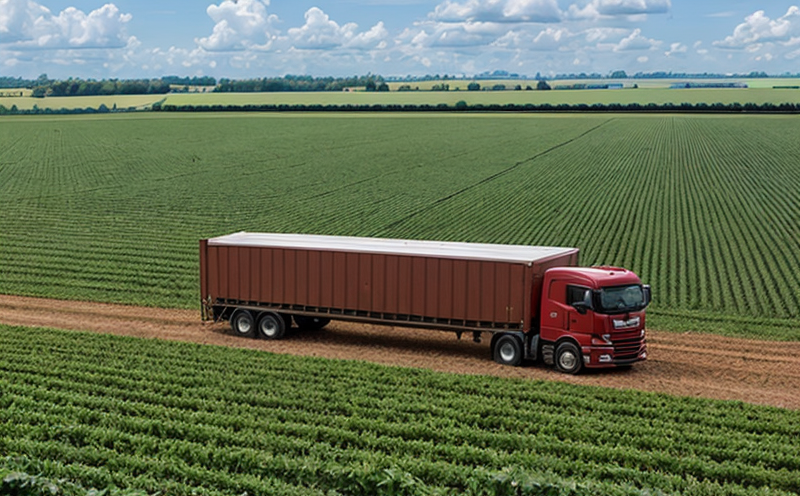Shock Impact Testing of Fragile Agricultural Produce
The testing and simulation of shock impacts on fragile agricultural produce is a critical service within the realm of Agriculture & Forestry Testing. This specialized service ensures that packaging materials and transport methods are capable of protecting sensitive goods during transit, thereby reducing spoilage and maintaining product integrity.
Shock impact testing simulates real-world conditions where products might encounter sudden changes in velocity or direction. These impacts can occur due to transportation over rough roads, handling by machinery, or even environmental factors such as drops from a truck bed or warehouse shelving. The primary goal of this service is to evaluate the resistance and durability of packaging materials under these stressors.
During testing, specimens are subjected to controlled impacts using specialized equipment designed to mimic various transport scenarios. Specimens include fruits like avocados, berries, apples, and citrus; vegetables such as tomatoes, leafy greens, and root crops; and other perishable items that require protection during distribution.
The test setup involves placing the specimen within its packaging in a controlled environment where it is subjected to impact forces. The force applied can range from low to high depending on expected conditions. Force measurement devices capture peak values which are then analyzed alongside displacement data to assess structural integrity and energy absorption capabilities of the packaging.
Acceptance criteria for successful testing vary based on industry standards but generally involve minimal damage to the product itself as well as its container upon impact. Compliance with relevant international standards like ISO 2631-1:1997 (Mechanical vibration - Evaluation of human exposure to whole-body vibration – Part 1: General requirements) and ASTM D4758-07(2014) (Standard Practice for Determining Shock Absorption Characteristics of Packaging Systems by Low Velocity Impacts) is essential.
| Application | Description |
|---|---|
| Fruit Transport | Varieties include apples, pears, peaches, and plums. Tests simulate jostling during harvest or shipment. |
| Vegetable Handling | Includes leafy greens like spinach, kale, and lettuce; also root crops such as carrots and beets. |
| Packaging Validation | Evaluation of new packaging designs to ensure they meet safety standards. |
| Transport Optimization | Determining optimal packing densities and methods for minimizing damage during transit. |
Benefits
The benefits of shock impact testing extend beyond just protecting products; they also contribute significantly to operational efficiency, customer satisfaction, and environmental sustainability. By identifying weak points early in the design process, businesses can prevent costly rejections at destination markets or ports.
- Enhanced Product Integrity: Ensures that goods arrive undamaged, preserving quality and value.
- Cost Reduction: Minimizes waste by preventing unnecessary returns due to damage during transit.
- Increased Customer Satisfaction: Happier customers lead to better reputations for companies involved in international trade or domestic distribution chains.
- Innovation Opportunity: Encourages innovation through iterative improvements based on test results, leading to more resilient packaging solutions.
Industry Applications
This service finds application across multiple sectors including agriculture, horticulture, and food processing. It plays a crucial role in ensuring that packaging materials can withstand the rigors of modern transportation networks.
- Agricultural Commodities: From fresh produce to processed items like jams and jellies, this service helps ensure their safe arrival at markets worldwide.
- Horticultural Products: Specialized for fruits, nuts, berries, and other delicacies that demand premium care during transport.
- Food Processing Industries: Ensures that even after undergoing processing steps like washing or cutting, products maintain their structural integrity through packaging designed specifically to protect them from shock impacts.
Environmental and Sustainability Contributions
The practice of conducting rigorous shock impact testing contributes positively towards environmental conservation efforts by minimizing waste associated with damaged goods. Effective protection measures reduce the need for excessive packaging, which in turn decreases landfill contributions.
- Reduced Waste: By ensuring products arrive intact, businesses can avoid sending back broken items for replacement or recycling.
- Eco-Friendly Packaging: Encourages the development of sustainable materials that are both protective and biodegradable.
- Energy Efficiency: Optimizing packing density reduces fuel consumption by allowing more goods to be transported per trip, thus lowering carbon footprint.





